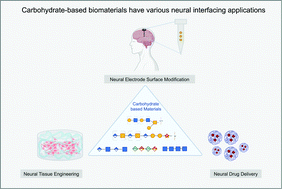Carbohydrate based biomaterials for neural interface applications
Abstract
Neuroprosthetic devices that record and modulate neural activities have demonstrated immense potential for bypassing or restoring lost neurological functions due to neural injuries and disorders. However, implantable electrical devices interfacing with brain tissue are susceptible to a series of inflammatory tissue responses along with mechanical or electrical failures which can affect the device performance over time. Several biomaterial strategies have been implemented to improve device–tissue integration for high quality and stable performance. Ranging from developing smaller, softer, and more flexible electrode designs to introducing bioactive coatings and drug-eluting layers on the electrode surface, such strategies have shown different degrees of success but with limitations. With their hydrophilic properties and specific bioactivities, carbohydrates offer a potential solution for addressing some of the limitations of the existing biomolecular approaches. In this review, we summarize the role of polysaccharides in the central nervous system, with a primary focus on glycoproteins and proteoglycans, to shed light on their untapped potential as biomaterials for neural implants. Utilization of glycosaminoglycans for neural interface and tissue regeneration applications is comprehensively reviewed to provide the current state of carbohydrate-based biomaterials for neural implants. Finally, we will discuss the challenges and opportunities of applying carbohydrate-based biomaterials for neural tissue interfaces.

- This article is part of the themed collection: Journal of Materials Chemistry B Recent Review Articles


 Please wait while we load your content...
Please wait while we load your content...